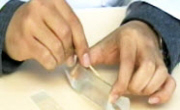This paper first clarifies that the development of diffractive thinking is as important as the cultivation of reflective thinking in moral education, and then suggests the direction of moral education for the cultivation of diffractive thinking. To th...
http://chineseinput.net/에서 pinyin(병음)방식으로 중국어를 변환할 수 있습니다.
변환된 중국어를 복사하여 사용하시면 됩니다.
- 中文 을 입력하시려면 zhongwen을 입력하시고 space를누르시면됩니다.
- 北京 을 입력하시려면 beijing을 입력하시고 space를 누르시면 됩니다.
https://www.riss.kr/link?id=A109580896
- 저자
- 발행기관
- 학술지명
- 권호사항
-
발행연도
2025
-
작성언어
Korean
- 주제어
-
KDC
37
-
등재정보
KCI등재
-
자료형태
학술저널
-
수록면
239-259(21쪽)
- 제공처
-
0
상세조회 -
0
다운로드
부가정보
다국어 초록 (Multilingual Abstract)
This paper first clarifies that the development of diffractive thinking is as important as the cultivation of reflective thinking in moral education, and then suggests the direction of moral education for the cultivation of diffractive thinking. To this end, I first compare and review the concepts of reflection, reflexivity, and diffraction, and then explore the characteristics of the ethico-onto-epistemology approach centered on the concepts of entanglement, agentic cut, and internal function advocated by Barad. Then, based on the explanation of the teaching methodological strengths of diffractive pedagogy, we suggest the direction of moral education for the cultivation of diffractive thinking. Teachers who teach morality need to guide students to actively participate in the process of becoming in order to cultivate diffractive thinking, and to make active efforts to realize the ecological self and develop the ability to respond. If teachers who teach morality provide students with sufficient opportunities to develop diffractive thinking, they will become deeply involved in the reality of the society they belong to, clearly understand their position in that reality, and deeply realize their ethical responsibility for it.
동일학술지(권/호) 다른 논문
-
롤스 『정의론』에 나타난 개인의 도덕적 역할과 능력 탐구 - 도덕 교육의 관점에서
- 한국도덕윤리과교육학회
- 박성근(Park, Sung Guen)
- 2025
- KCI등재
-
- 한국도덕윤리과교육학회
- 박언진(Park Eon-jin)
- 2025
- KCI등재
-
탈콜버그주의와 신아리스토텔레스주의의 경계와 접점에 대한 연구
- 한국도덕윤리과교육학회
- 양해성(Yang, Hae Sung)
- 2025
- KCI등재
-
- 한국도덕윤리과교육학회
- 편집부(편집자)
- 2025
- KCI등재





 DBpia
DBpia






